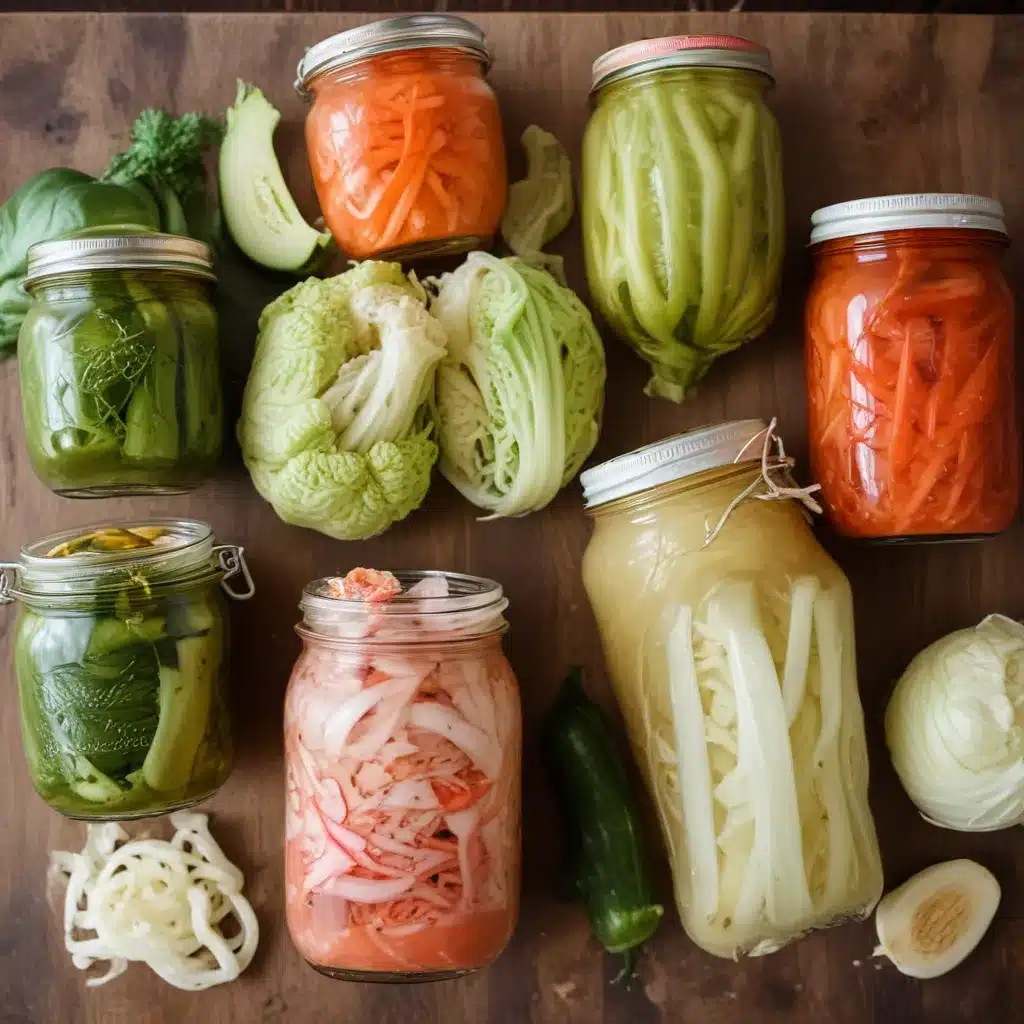
In the heart of the Crooked Pines Farm, we passionately believe that the key to vibrant health and delicious cuisine lies in the probiotic-rich world of fermentation. As a farm educator, I’m excited to share the ins and outs of crafting wholesome, flavorful ferments right in your own kitchen.
Fermentation Techniques
Fermentation is a magical transformation that has been used for centuries to preserve and enhance the nutritional value of fruits, vegetables, and other foods. At its core, fermentation is an anaerobic process where microorganisms like bacteria and yeast convert carbohydrates into acids, gases, and alcohols. This process not only extends the shelf life of produce but also unlocks a bounty of beneficial probiotics, enzymes, and vitamins.
Lacto-fermentation is the most common form of fermentation used in the creation of sauerkraut, kimchi, and pickles. This technique relies on lactic acid bacteria (LAB) that naturally occur on the surface of many plants. When submerged in a brine solution, these LAB thrive, producing lactic acid that preserves the food and gives it a signature tangy flavor.
In contrast, aerobic fermentation involves exposing the ferment to oxygen, allowing other microbes like yeasts and molds to flourish. This process is often used to make kombucha, kefir, and some vinegars.
Homemade Fermented Foods
Fermented foods are a cornerstone of a healthy, balanced diet, providing a daily dose of gut-nourishing probiotics. Let’s dive into three of our favorite homemade ferments from the Crooked Pines Farm kitchen.
Sauerkraut
Sauerkraut, the quintessential fermented cabbage, is a staple in many traditional cuisines. To make it, simply shred fresh, crisp green or red cabbage, mix it with salt, and let the natural fermentation process work its magic. As the bacteria break down the cabbage, they produce lactic acid, resulting in a delightfully tangy and crunchy sauerkraut.
The key to perfect sauerkraut is maintaining the proper salt-to-cabbage ratio, typically around 2-3% salt by weight. This encourages the growth of beneficial LAB while discouraging spoilage bacteria. Packing the shredded cabbage into a fermenting vessel, weighing it down to keep it submerged in the brine, and allowing it to ferment for 4-6 weeks results in a flavorful, probiotic-rich sauerkraut.
Kimchi
Hailing from Korea, kimchi is a spicy, flavor-packed fermented vegetable dish that has gained global popularity. While the traditional version is made with Napa cabbage, you can easily adapt the recipe to use seasonal produce like radishes, carrots, or even green tomatoes.
The key to delicious kimchi lies in the blend of seasonings, which often includes Korean red pepper powder, garlic, ginger, scallions, and fish sauce. After massaging the vegetables with this aromatic paste, you’ll pack them into a fermentation vessel, weight them down, and allow the lactic acid bacteria to work their magic over 1-4 weeks.
The end result is a vibrant, pungent, and probiotic-rich condiment that can be enjoyed on its own, used as a sandwich topping, or incorporated into stir-fries, rice dishes, and more.
Pickles
Whether you’re growing an abundance of crisp cucumbers or have access to a farmers market haul, homemade pickles are a fantastic way to preserve the summer’s bounty. The lacto-fermentation process transforms plain cucumbers into a tangy, crunchy treat packed with gut-healthy probiotics.
To make pickles, you’ll submerge sliced or whole cucumbers in a salt brine along with aromatic additions like garlic, dill, peppercorns, and bay leaves. As the fermentation takes place over 4-6 weeks, the lactic acid produced by the bacteria will give your pickles their signature sour and fizzy profile.
Once the fermentation is complete, you can transfer the pickles to the refrigerator, where they’ll keep for several months. Enjoy them as a side dish, layer them onto sandwiches, or chop them up for relish.
Ingredient Selection
When crafting homemade ferments, sourcing high-quality, fresh ingredients is key. First and foremost, we recommend using seasonal, organic produce whenever possible. Locally grown fruits and veggies will not only be at the peak of freshness but will also support your regional food system.
That said, we understand that certain ingredients, like spices or specialty produce, may not always be available locally. In these cases, it’s perfectly acceptable to supplement with non-organic or imported items to ensure a successful ferment.
When it comes to flavor pairings, the possibilities are endless. Experiment with unique combinations like ginger and turmeric in your kimchi or dill and horseradish in your pickles. The world of fermentation is your oyster!
Preparation Methods
Crafting homemade ferments is a straightforward process that requires minimal equipment. Begin by chopping or slicing your produce into the desired size and shape. For sauerkraut, you’ll want to shred the cabbage into thin strips, while for pickles, you can leave the cucumbers whole or slice them into chips or spears.
Next, you’ll mix the produce with salt to draw out the natural juices, creating the brine that will protect your ferment from spoilage. The specific salt-to-produce ratio will vary depending on the recipe, but a good starting point is 2-3% salt by weight.
Finally, you’ll pack the salted produce into a fermentation vessel, such as a mason jar or ceramic crock, and weigh it down to keep it submerged in the brine. Cover the vessel with a fermentation lid or airlock system to allow gases to escape while preventing oxygen from entering.
From there, it’s simply a matter of waiting patiently as the lactic acid bacteria work their magic, transforming the ordinary into the extraordinary. Taste your ferments periodically, and when they’ve reached your desired flavor profile, transfer them to the refrigerator to enjoy for months to come.
Ready to get fermenting? Visit Crooked Pines Farm to explore our collection of farm-inspired fermentation recipes and resources. Unlock the power of probiotics and discover the joy of homemade, farm-to-table ferments!


